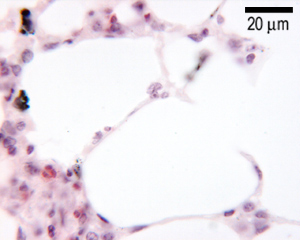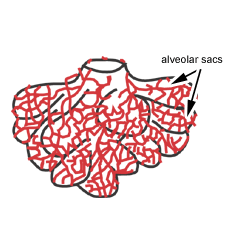This is a cross section through the lung, can you identify alveolar sacs and alveoli?

This is a section through the lung at higher magnification. Can you identify the thin type I pneumocytes, macrophages and capillaries?

This diagram shows a diagram of an alveolar sac, showing how the organisation of the alveoli, and the network of blood capillaries that surround the alveoli (in red).
The epithelium of the alveoli, contains two main types of cells:
- type I pneumocytes: large flattened cells - (95% of the total alveolar area) which present a very thin diffusion barrier for gases.
- type II pneumocytes (making up 5% of the total alveolar area, but 60% of cells). These cells secrete 'surfactant' which decreases the surface tension between the thin alveolar walls, and stops alveoli collapsing when you breathe out.
Macrophages are also present.